There are so many reasons to want to add ducks to your homestead – ease of care, eggs, meat, insect control, and entertainment, to name a few.
For me, though, one of the most incredible things about raising ducks is how much they poop. Yes – I know, this isn’t something most people talk about (at least not in public). But, if you are a homesteader and growing your food, finding good sources of fertilizer for your garden and edible landscapes is a top priority.
So, I say yahoo for duck poo! And here’s why:
- Quantity: You get about 0.065 pounds of poop per day, per pound of laying chicken. But you get 0.11 pounds of poop per pound of duck per day. Although it may not sound like a big difference, if you have ten ducks that are 6 pounds each, that means 6.6 pounds of manure per day on average. The same 60 pounds worth of laying hens gets you 3.9 pounds of poop per day. In a year, using ducks as a source of fertilizer, you get almost 1000 pounds more duck poop from a similarly sized flock.
- Nutrient Content: Almost all livestock manure is awesome for your garden (so long as the animals were raised well), but duck poop is the bomb! Duck poop is basically like a 2.8:2.3:1.7 NPK fertilizer. According to the same source, no other livestock manure has NPK ratio this high. The closest one is turkey with 2.8/2.4/1.2 but with less poop per pound per day. This means with duck you get the most poop per day and you need the least poop to get the same level of fertilizer.
- Dispersal: Duck poop is more liquid than other forms of manure which mean between regular rain and ducks plodding over it, duck manure disperses very quickly into the soil.
Now that you know why duck poop is such a powerful source of fertilizer on the homestead let’s talk about a few ways to use it.
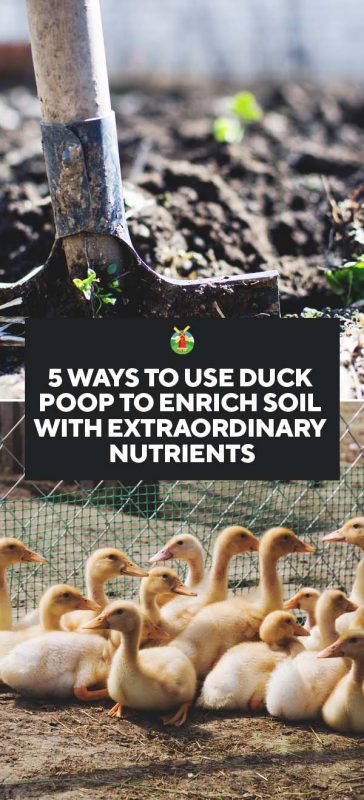
Table of Contents
Ways to Use Duck Poop to Fertilize Your Garden
Method 1: Edible Access
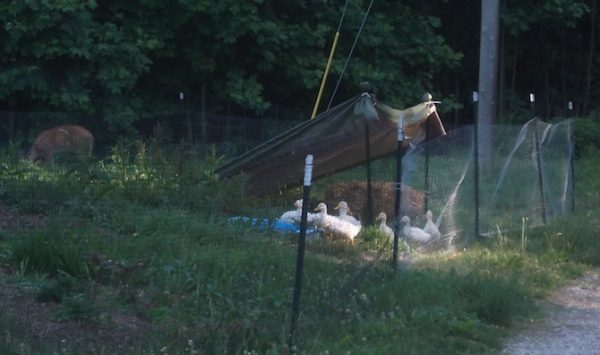
Letting your ducks wander directly through your edible landscapes is an excellent way to spread the ‘goodness’ with minimal work on your part. But there are a few things you need to know though.
Ducks need direction. They are creatures of habit, and if you just let them have total access to your landscape at all times, they will forage a bit. Then they’ll spend the rest of their day lounging out in their favorite places. If they are allowed to lounge too long in any one area, they overload areas with poop and stifle plant growth.
If you want to move ducks around your landscape, get them in the habit of following you to a new area every few days using a feed bucket. Fill kiddie pools with water and set them in that location to encourage ducks to stick around. Make sure there are shaded areas and sunny spots so ducks can be comfortable.
Sometimes just moving their food and water sources to new areas, full of fresh weeds and bugs, will be enough to direct their droppings. However, if you happen to have a large pond or more alluring spaces that might tempt ducks away from their work, then you will have to use temporary fencing to keep ducks where you want them.
When using ducks in undeveloped areas with no shade, you can create temporary shelters using straw bales, stakes, and tarps.
Electric poultry netting works well so long as you have an excellent charger. Ducks are heavily feathered and tend to be more resistant to shock discouragement than other kinds of livestock.
For birds that don’t fly well, just putting up inexpensive plastic netting (e.g. the 100-foot rolls you can get for deer protection) around garden stakes can also work well to keep most of your ducks contained. Since ducks tend to stick together, as long as most of them stay in the designated areas, even escape artist ducks will linger close to the confinement area.
This method works best in established edible landscapes with mature plants, for example under fruit trees. It also works well to develop new areas that have not yet been planted. Avoid letting ducks wander among newly planted areas as disturbed soil encourages them to dig for insects with their beaks. Ducks also tend to trample tender plants.
Method 2: Water Your Growing Areas with Pond Water
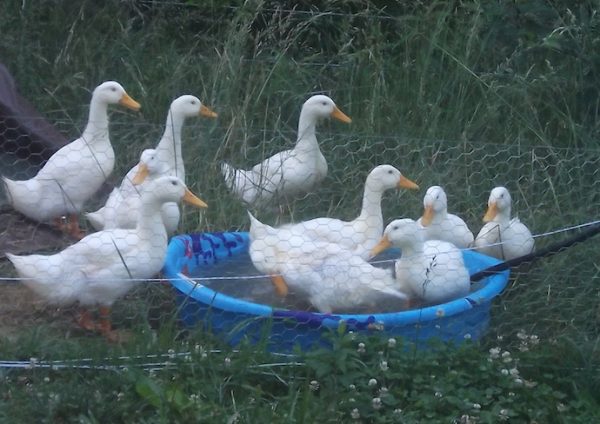
If you have a permanent pond that ducks swim and poop in, you can usually directly water your garden and edible landscape areas with your pond water. You can simply dip a bucket and dump it where you need it. Or you can get a bit more sophisticated and use gravity or pumps to do the work for you.
If you are just getting started and can choose where to site your duck pond, aim high. If your pond is higher than the rest of your landscape, you can use gravity to do the work of moving duck water for you.
One of our ponds sits uphill from our garden. We have a flock of ducks that live on and around that pond during the growing season. All we have to do to move water from the pond to our garden, is put one end of a hose in our pond, create a suction to draw out the water, and then let it run downhill to our garden.
We’re super low-tech around here. So we connected our pond hose to our house hose bib. We turned on the water from our house and let it run until it was pouring out at the pond. Then we turned off the water at the house which then began to draw back the water from the pond. We quickly connected our hose to a float valve. The float valve keeps that suction we created on all the time.
We put the float valve on a 55-gallon drum, so we always have a ready supply of water in the garden. We can also just take off the float valve and directly water our garden using the hose any time we want. Then we can reconnect the float valve to stop the flow and keep the suction going.
If you don’t have a high pond, then you’ll have to look into pumps. Electric, gas, and even human-powered pumps can all work. You just have to do some research to make sure you get the right pump to move water over both the distance and elevation change to your edible landscape locations.
Kiddie ponds can be emptied daily directly under fruit trees and other established plants.
Method 3: Compost your Duck Litter
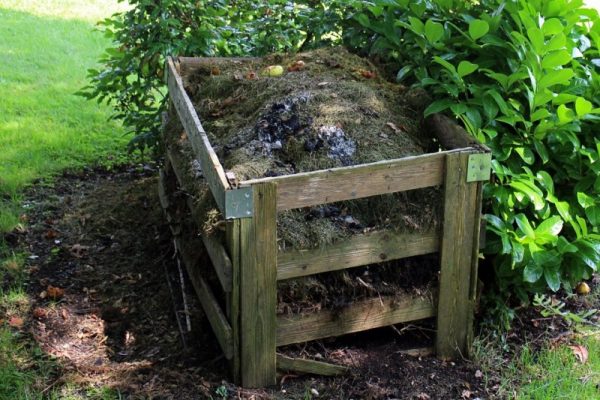
I confine my ducks at dusk until about 9:00 am to collect their eggs and keep them safe from predators. It also makes it easier for me to collect their overnight manure.
As we mentioned earlier, duck poop is a bit runny. So, you can’t just scrape and sweep it up like you can with chickens. Given the quantity produced, you’re going to need a lot of litter to keep your ducks from dancing in doo each night. But that’s OK because:
Litter + Poop = Compost
Since hay grows well in my area, is super cheap, and is almost always minimally sprayed, I use hay as duck litter. It takes about one square bale of hay each week for 20 ducks.
Each morning when I let the ducks out, I dump their water around their duck house to more evenly disperse their manure. I layer on about an inch of fresh hay. Straw, wood shavings, and sawdust will also work.
At night, I fill their water and food bowls and close the ducks in at night. The next day I dump the water and apply hay. I do this for about two weeks. Then I use a pitchfork and move all that manured hay into a compost pile. I usually just build the pile to about 4 feet high by 4 feet wide and let it sit there for six months until it is mostly black and crumbly.
Method 4: Don’t Want to Build a Pile? Go Mobile!
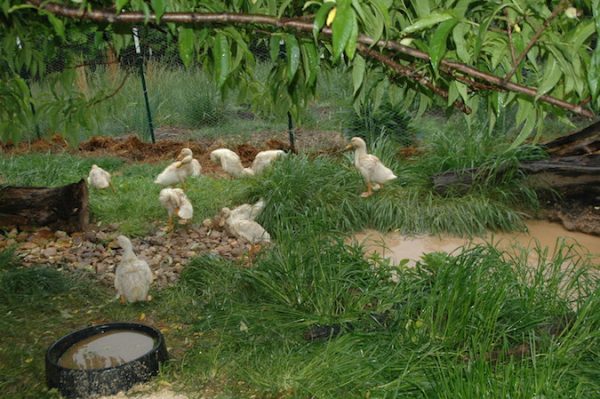
If pitchforking poop is not your thing, then think about a mobile duck coop. Ducks don’t like to climb ramps and roost high as chickens do. So consider using a movable chain link cube with wheels and a tarp top as a duck house alternative.
You can just let ducks have the floor overnight. Add in a couple of movable nest boxes (or not since ducks don’t necessarily use them anyway), and you’re set!
Put your coop in place. Use the same procedure detailed above for a fixed coop. Then after two weeks move your coop. Leave all that good stuff in place, and come back and plant in it a month later.
If you have a lot of predator pressure, consider an electric fence to protect your ducks at night better.
Method 5: Duck and Cover (Crops)
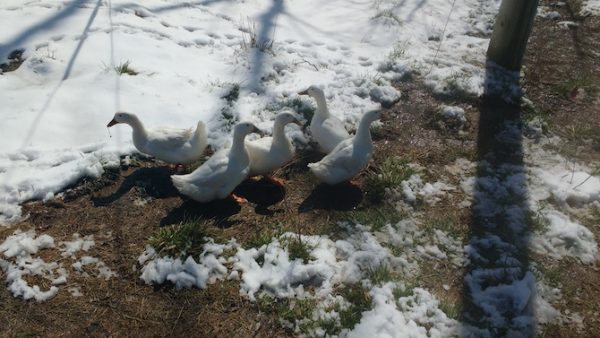
If your land is light on organic matter, consider using ducks to help you with your cover cropping. After using either the Go Mobile or the Edible Access method, plant your cover crops.
When you would normally bring in the mower to chop and drop all those cover crops, instead bring back the ducks. The ducks will eat your cover crops, apply more poop, and smother whatever they don’t eat. Then you can move the ducks off, plant your next round cover crop and repeat. If you do this several times, you’ll build soil mass in a hurry and help cut your duck feed costs as well.
Make sure you plant things that are edible for your ducks. Most cover crops are, but do a little research just to be sure. Buckwheat, hard winter wheat, tillage radishes, mustard, rye, Austrian peas, and clovers all work well.
I don’t know about you, but I think all these great ways to use duck poop around the homestead are worth crowing about! So, say it with me…
DUCK-ER-DOO-DLE-DOO!!












































